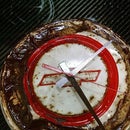Introduction: How I Ended Up Mopping the Ceiling...
Have you ever mopped your kitchen ceiling? No?
Me neither. Until I cleaned the fridge one day...
Things started off innocent enough. There wasn't even a "Hold my beer and watch this!" moment. No Redbull either.
No, aside from the ranch dressing (or was it expired milk...) that had turned into a bio-hazard and needed to be disposed of this was just a boring day in normal life and there were chores to do.
My job was to clean out the fridge. So to get started I pulled everything out of the fridge. Then I wiped down the shelves. Next was to sort through things and get rid of the expired items. Did you know penicillin could grow on ketchup? I didn't.
After shooting baskets into the trash can with the expired items I ran across a glass bottle full of brown sediment. It was old yeast leftover from brewing beer. I figured it wasn’t a good idea to throw a full glass bottle and instead put it in the sink.
Next I put everything what wasn’t expired back into the fridge. Then I wiped down the counters where the fridge stuff had sat. Now it was time to empty the glass bottle so I could recycle it.
I grabbed the bottle opener and just barley touched the lid of the bottle when
BOOM!
The contents of the bottle evacuated itself all over the kitchen celling. And my face.
I stood there stunned trying to figure out why people were laughing.
After a few seconds I figured out what had happened. And after a few more seconds I also realized that I would now get the opportunity to clean the rest of the kitchen. Including the ceiling.
This experience taught me a very important life lesson - Bribe someone else to clean the refrigerator next time!
Step 1: Yeast Bomb!
What happened?
I usually save some yeast from the current batch of beer in order to make the next batch of beer. It takes beer to make beer right?! Reusing yeast also adds a unique flavor, character and depth to the beer palate profile. Resulting in a uniqueness that is unparalleled and impossible to copy.
Sure does. It also costs less.
Anyway, this batch of beer had an extremely "active" fermentation and blew out it's airlocks and made a pretty good mess. Once it fermented out, for whatever reason this time I grabbed a 22oz. beer bottle to save the yeast in. Topped it off, capped it and put it in the fridge. I then forgot about it and left it in the fridge for too long. That should be no big deal...
But, while cleaning the fridge I let the bottle warm up for awhile on the counter top. Pressure built up inside the bottle, I went to open it, the opening of the bottle was small and funnel like and then BOOM! Yeast explosion.
I can't say for sure that's what caused it, but that's my best guess.
Step 2: Diffusing the Yeast Bomb.
Cut the red wire!
Wait, no, wrong instructable...
I normally save yeast in mason jars. Or pickle jars, or spaghetti sauce jars. Basically anything with a large opening. It makes it easier to fill. And you can also crack the lid to let any built up pressure escape before you end up yeasting the ceiling like I did.
Trust me on this one, it's better to store yeast in mason jars than beer bottles. In fact I'm still finding yeast in places...
If this instructable gave you a laugh or two, please consider throwing me a vote in the Epic Fail contest!
Step 3: More Yeasty Goodness.
Ultra-Indigo had a good suggestion to add some more info on yeast washing, thanks!
You guys probably already know this, but it's worth saying again:
Number 1 priority - Make sure everything is super-duper clean and SANITARY!
Quick tip - One of the easiest thing to do if you’ve planned ahead enough is to pitch your wort right onto a fresh yeast cake from your previous batch. But I’m not usually able to brew back to back so I end up saving yeast.
Here’s the link to the blog post that got me interested in trying to save yeast: http://beersmith.com/blog/2008/07/25/yeast-washin...
The cliff notes are:
- Sanitize the jars and lids you're going to use to save your yeast in. You need at least 2.
- Try to save yeast from your primary fermentor, it's more active.
- If needed, use clean water to help break up the yeast cake and pour it into the sanitary jars.
- Loosely screw on the cap, let it sit for about an hour in your fridge.
- The stuff that settles out we don't want, pour off the liquid into another jar.
- Top the jar off with clean water, screw the lid on tight, put it in the fridge.
- You can store it for a couple months without issue.
- Make a yeast starter before you use the yeast again.
- Use the yeast only in similar beer styles, ie - don't use a yeast you brewed a porter with to make a pilsner.
- I usually toss the yeast after about 4 or 5 batches.
As far as what can go wrong and what to watch out for, this link has helped me out: http://www.brewersfriend.com/2011/11/12/infected-b...
Thanks for reading!

Second Prize in the
Spectacular Failures Contest













